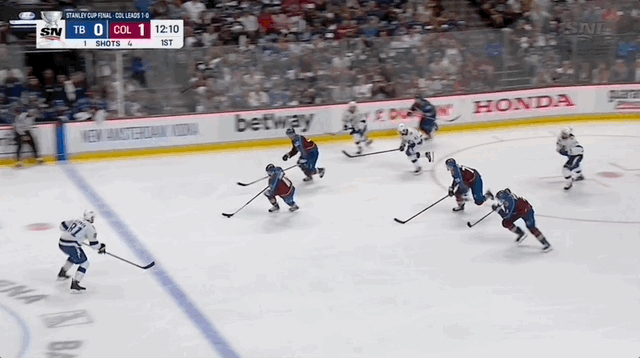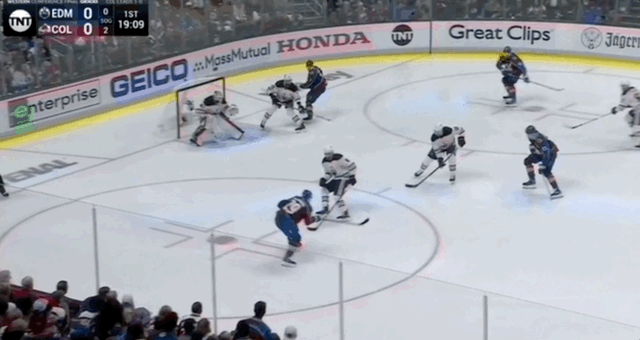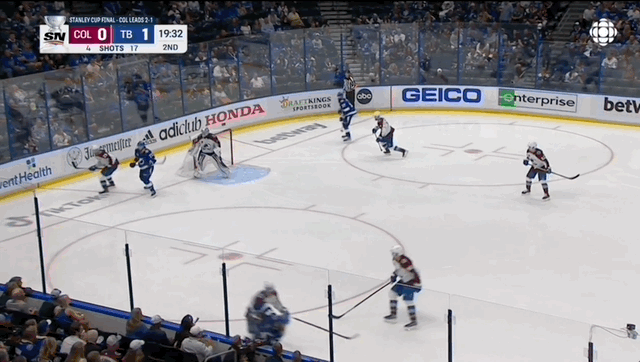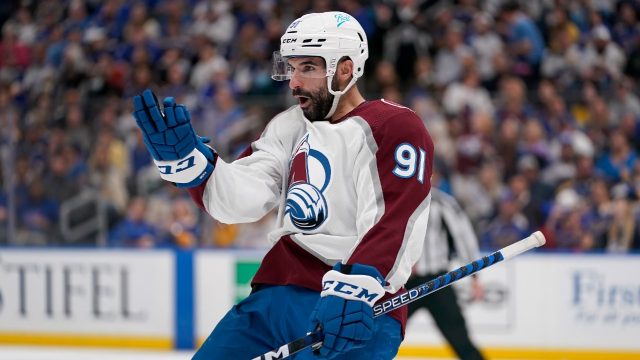Hockey is filled with narratives, especially when the post-season rolls around. With two teams left in the Stanley Cup Final, the attention is on the Lightning and Avalanche. Naturally, there are more than enough narratives to go around this series.
Just because there’s a narrative floating around, doesn’t make it true. So we’re diving into the numbers to break down fact versus fiction.
Andrei Vasilevskiy’s weak high-blocker side
Everyone knows Vasilevskiy’s one of the best goaltenders in the world, especially in the post-season. But this year, one area that's been focused in on for the Lightning goaler: his high-blocker side. Just look to the overtime winner in Game 4.
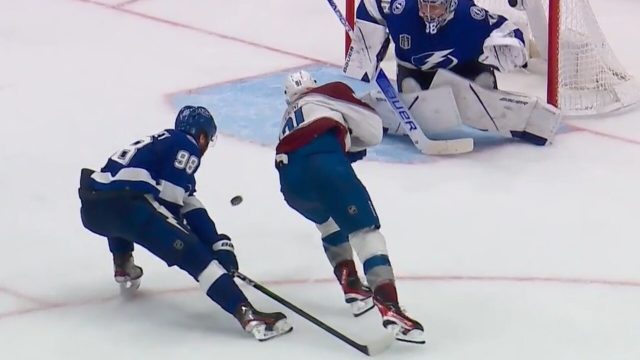
So, is this a weakness for him?
In the regular season last year, 36.6 per cent of the goals scored against Vasilevskiy went high blocker, which was slightly above league-average in all situations of 33.8 per cent. Fast forward to the 2021 post-season, he was pretty much right on target with league-average in the 31 per cent range.
This year, there has been an uptick in the percentage of goals beating Vasilevskiy high-blocker — up to 42.3 per cent in the regular season, and around 46 in the playoffs. League average, to compare, was pretty consistent from 2020-21 at about 32 per cent both in the regular season and post-season.
So there’s actually some merit to this narrative. Had the league-average risen as well, maybe the overall uptick in goal scoring could be cause. Instead, there has been an upward trend for Vasilevskiy all year, and opponents have probably spotted it in their scouting reports.
Vasilevskiy’s the first legitimate starting goalie Colorado has faced
This one’s a bit trickier. Against Nashville, Colorado went up against a second-stringer for a bit before really taking on a third-stringer in Connor Ingram. In Round 2, technically Jordan Binnington was the 1B/backup in St. Louis from the regular season but earned the starter’s crease in the post-season. And prior to his injury, he did save 2.9 goals above expected which is nothing to shrug at.
Right or wrong, Mike Smith is the starter in Edmonton — and his play did match expectations heading into the Western Conference Final.
So technically, Vasilevskiy isn’t the first starting goalie the Avalanche have faced. He’s just the best goaltender. And that was going to be the case regardless of who won that Eastern Conference Final, seeing as it was a matchup of two of the best goalies in the playoffs.
Altitude’s influence on Tampa Bay’s game
Okay, maybe our measuring capabilities are a bit more limited here. We can’t tell you that’s the reason Tampa Bay lost both Games 1 and 2, and ignore the fact that the Avalanche may legitimately just be the stronger team. And we can’t act as if no team has been able to win in Colorado. The Avalanche would have been 41-0 at home in the regular season, and perfect in the post-season — although they’ve been close, with only two losses on home ice, to the Blues 4-1 in Game 2 and 5-4 in overtime in Game 5. Then again, not every team has had an opportunity to shift the series back to Denver for a Game 5; the Predators and Oilers couldn’t even get to that point which makes this even tougher to judge.
Is it possible the altitude affected the Lightning, especially in Game 2? Without a doubt. There’s no denying that Tampa Bay got dominated and actually looked gassed. This game was so tilted for Colorado at even strength:
• 50-22 in shot attempts
• 23-6 in attempts from the slot
• 12-5 in passes to the slot
• 8-0 in shot attempts off the cycle
• 9-2 in shot attempts off the rush
• 6-0 in odd-man rushes
But there are other factors to consider as well, from the number of games the Lightning have taken to get to the Final versus Colorado, the number of injuries piling up on Tampa Bay, or the fact that the Avalanche are that good of a team.

Cale Makar ascending to one of the best defencemen in the game
Victor Hedman may be the best defenceman in the league of the past however many years. But Makar is outright the top of his position this season and has become one of the best players in the league. The post-season has only furthered that.
The scoresheet indicates his abilities, to an extent, with 27 points in 18 games. Digging below the surface only furthers that. There’s his power play impact and his penalty killing, that he’s been a bigger part of this season. Then there’s his play at 5-on-5. Among the position (and skaters with at least 50 minutes of ice time), Makar’s seventh with 11 carry-outs from the defensive end per 60. He’s skated into the offensive zone with the puck on his stick at the fourth-highest rate (6.26 per 60), as well.
Makar’s been successful at separating opponents from the puck with his stick, and makes defensive plays to extend zone time whether he’s blocking passes or holding the blue line. This year’s Norris winner also does well to set up his teammates with passes, and is one of the most frequent shooting defenders who can get to the quality areas of the ice.
With offensive defencemen, sometimes their play in their own zone can be questioned. For Makar, he plays a much more modern game where the best defence is possessing the puck. But he showed that he can go head-to-head with the best — just look to Round 3 when he matched up against Connor McDavid. In those minutes, Colorado maintained the edge in shots and quality chances and Makar played a key role in it.
Nathan MacKinnon versus Anthony Cirelli
Cirelli is this year’s Phillip Danault. He went up against Auston Matthews and Aleksandar Barkov in the Atlantic Division, and came out on the winning side. Then he faced Mika Zibanejad in the Eastern Conference Final and outright shutdown one of the best offensive threats the Rangers had to offer.
The Stanley Cup Final offered his toughest matchup yet, facing Nathan MacKinnon. In Games 1 and 2, Colorado had home ice advantage. Head coach Jared Bednar and his staff did their best to free up one of their best offensive players by deploying him in softer matchups. Once the series shifted back to Tampa Bay, Jon Cooper gained that edge which meant putting Cirelli out against MacKinnon every opportunity he got.
In Game 3, the two were on the ice together for over 11 minutes at 5-on-5. In that time, Colorado out-attempted Tampa Bay 19-7. That edge in attempts was narrowed to 8-5 in shots thanks to the Lightning’s shot-blocking ability, and some missed shots. When it came to quality chances, the Avalanche had the outright edge as well, 7-2.
In Game 4, Cirelli got an even heavier dose of MacKinnon -- about 19 five-on-five minutes. And the Lightning did a much better job in those minutes of this matchup -- almost even in shot attempts, with 21 of their own to Colorado’s 22. Tampa’s shot blocking gave them a plus-three advantage in shots on goal (11-8). And while they didn’t manage to keep the Avalanche out of the slot entirely, the gap was a lot closer at 8-6 in the away team’s favour.
So this is a narrative worth keeping an eye on, especially if this series extends to six games and swings back to Florida. Tampa Bay definitely isn’t shutting down MacKinnon’s line, but they’re putting in the work to contain them as much as possible by deploying Cirelli.
But it’s worth watching the entire units involved in these, and the wingers to match each centre.
Data via Sportlogiq
